Raijin’s flashes: Ki-84 Hayate, 182nd Shinbu Tai
At the beginning of this article I will take the liberty of going back a little and of placing this model of a Ki-84 Hayate in my personal modelling biography. Around 2005 the latent modelling virus, which had been latent since my youth, caught me again, and since then I have been constantly feverish for this passion. One of the first kits I bought and built was this Ki-84 in a large scale, which I was not familiar with at that time. Full of enthusiasm about the model, which was mastered according to my demands at that time, I bought two more kits as well as a decal set of Eagle Strike, which have accompanied me for fifteen years now, unbuilt and patiently waiting.
This autumn the time had come: plastic, scratched parts as well as the decals were now well enough "hung" to finally turn this long lasting intention into a finished project. The construction of these models, which took place in parallel, on the one hand led me back to my beginnings in model making and on the other hand let me experience again, where there is still new ground to be discovered and new experiences to be gained. I would like to present here first the model of the Ki-84 flown by First Lieutenant Imoto.
To the model
In summer 1945 this machine was assigned to the 182nd Shinbu Tai in Tatebayashi /Honshu, Japan. Shinbu Tai units were classified as "special attack units", a euphemism for the obligation to carry out suicide missions. As one of the strongest combat designs in Japan's flying arsenal, the Hayate were given preference for defending the high-flying B-29 Superfortress.
One tactic that led individual pilots of Shinbu Tai units to even more than one " kill " was to ram the bombers. If the Ki-84 pilot survived this and managed to parachute out, he could be used for another of these missions.
It is interesting, by the way, that the conspicuous marking with the stylized flashes on both sides of the fuselage indicate this suicidal purpose.
In the Buddhist Shintoist tradition, lightning is attributed as an attribute and weapon to the influential celestial being Raijin, also known as Raiden Sama. This deity enjoys great popularity, as he once fought off the Mongolian fleet as the god of wind and lord of lightning and thunder, thus saving Japan from invasion. The name of this storm created by divine intervention is also known outside Japan: kamikaze.
The aircraft shown was flown by the commander of the 182nd, First Lieutenant Takeshi Imoto. Unfortunately I could not find further information about Imoto. It is certain, however, that his Ki-84 Hayate survived the end of the war and was photographed after the armistice. The photo shows her standing on an airfield packed with aeroplanes with the propeller dismantled, probably waiting to be scrapped.
To the kit
The plastic moulds date back to 2004, but even today you can experience why Hasegawa kits are so popular. The details that can be found in the pleasant and not too brittle plastic are partly impressive. For example, there are slotted screws on the metal sheets of the engine fairing, which are individually aligned! This quality is complemented by a fit near to perfect
But it is also typical that Hasegawa takes the direct route: they only provide what can be seen. In this respect, the inner life within the beautiful sheet metal depictions is rudimentary or non-existent. But this is also a quality that is not to be sneezed at, because the building is designed without frills, compact and in no way proves to be "overengineered".
A few scratched parts are good for the appearance of the Ki-84 Hayate in the light of today's demands, although the market for the Ki-84 Hayate offers numerous possibilities for upgrading. I chose Eduard harnesses as well as the "interior set" for my specimens, the replicas of the Homare engines were refined with ignition cables, once as scratched part, and secondly self-made from copper wire.
To the construction
For the depiction of the battered and in some places already heavily chipped surface, I used the technique of dabbing masking liquid with a sponge onto the metal surface prepared with Alclad. Afterwards the surface is finished in colour. After finishing, the hardened masking can be rubbed off, which then shows the again bright aluminium surfaces.
In the following step I covered the surface with a liquid and sprayed the surface colour to modify the effect in an interesting way.
The decals of both machines come, as mentioned at the beginning, from the recommendable Eagle Strike sheet "Imperial Hayates. Part II" and can still be processed without problems after more than a decade. As it was logical with the size and position, Raijin's flashes were not shown by decal, but masked and sprayed.
Finally I would like to summarize my positive experiences with this kit: if there were not so many other kits available, I would like to build a fourth Ki-84 Hayabusa from Hasegawa!
But who knows, maybe...
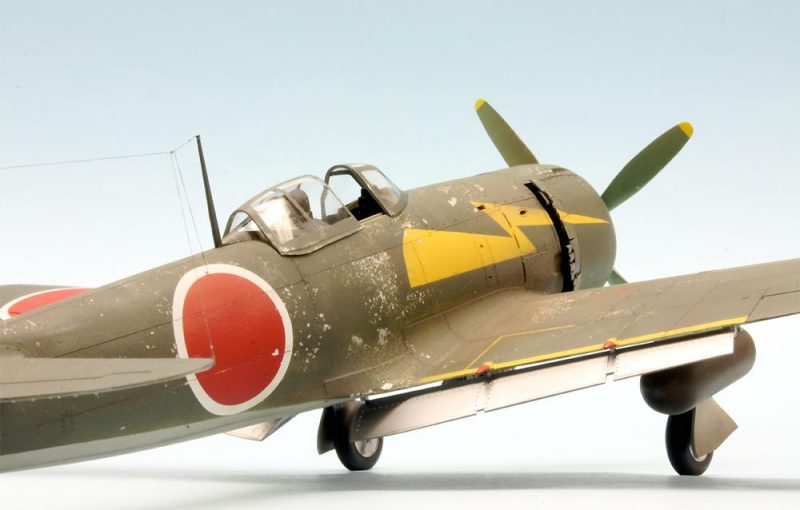
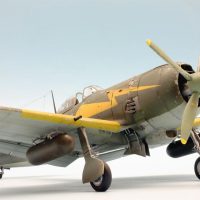
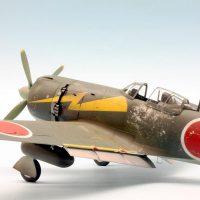
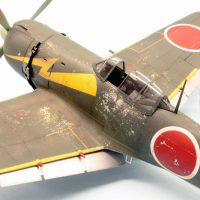
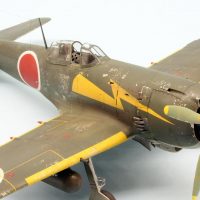

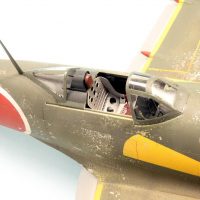
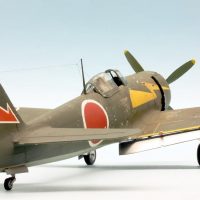
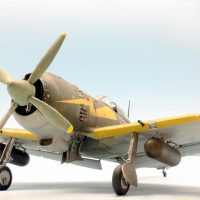
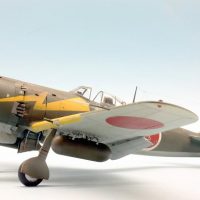
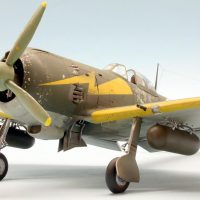
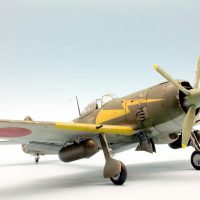
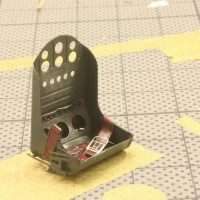
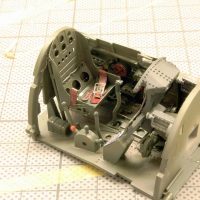
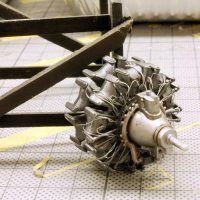

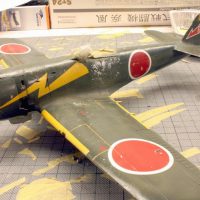
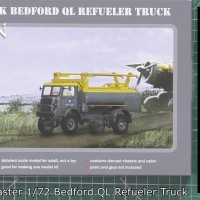
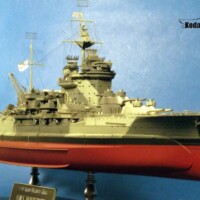
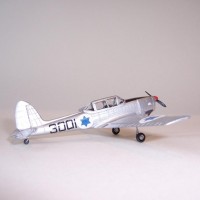
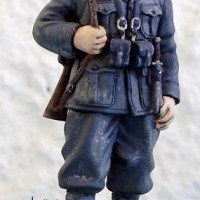
Wieder ein Gustostückerl! Looks great, nice chipping effects
Big and beautiful, one of the best I’ve seen. What colour did you paint those drop tanks, they look very good Roland
Thanks Pedro! Acrylic colours from Gunze were used: H 85 Interior Green as primer, then, in a thin transparent layer, "Olive Drab".
Very nice job on this model, the details in the cockpit, the paintjob and weathering are excellent. Congratulations !
Beautiful work!
Excellent build, great paint work.
Fantastic build, Roland.
The detailing is very nice, even so the chipping.
Well done.
Many thanks for your encouragement and motivating comments! I am very pleased that you like this Hayate!
Echoing above gents comments, let me also congratulate you Roland @rosachsenhofer!
This is a wonderul build, with your usual meticulous attention to detail.
The accompanying article was excellent too.
Well done!
Awesome weathering!
You've certainly learned a lot in 15 years, sir. This is an excellent bit of work and a great result.
The Hasegawa Ki.84, in either 1/48 or 1/32 (the 1/32 being a scale-up of the excellent 1/48) are definitely among the company's best products.
That is one great build
A beautiful build, Roland (@rosachsenhofer).
I built one of these 10 years ago and still remember it as a fantastic kit.
I must get myself another one...
Well done!
This is all very motivating, thank you all for these comments!
Great model.
You successfully avoid to get in standard trap related to Japanese fighters, overdoing the weathering. This looks perfect.
Best regards
Djordje
A beautiful build all the way around - well done!
Roland, @rosachsenhofer
I like what you have done here. It looks exceptional. The comments posted by everyone above are testament to your skill set. This model is a magnificent build. Well done my friend, and I too pressed the "liked" button.
I have one of these Hasegawa 1/32 scale Hayate models in the stash. Mine is one of the prototype machines, and it offers several different parts from the standard kit. You might have just talked me into building it up too as part of our ongoing Empire of Japan group build. I am almost finished with the Ki-44 Shoki, and have a Hien along with a Raiden planned next. These kits are all molded by Hasegawa, and are in 1/32 scale.